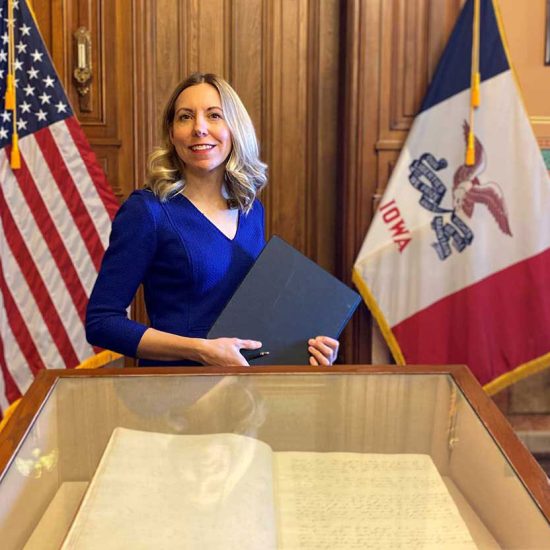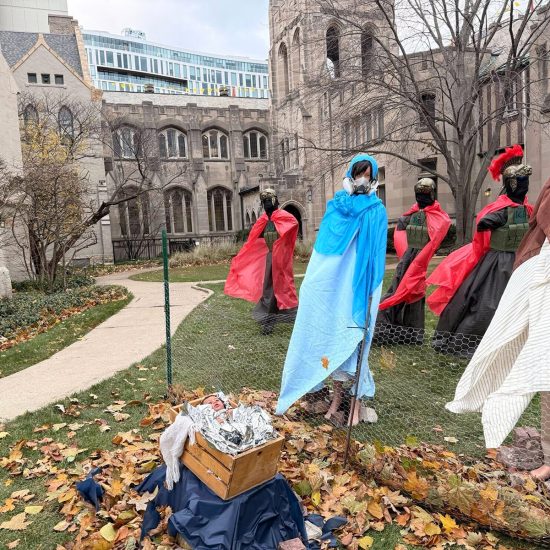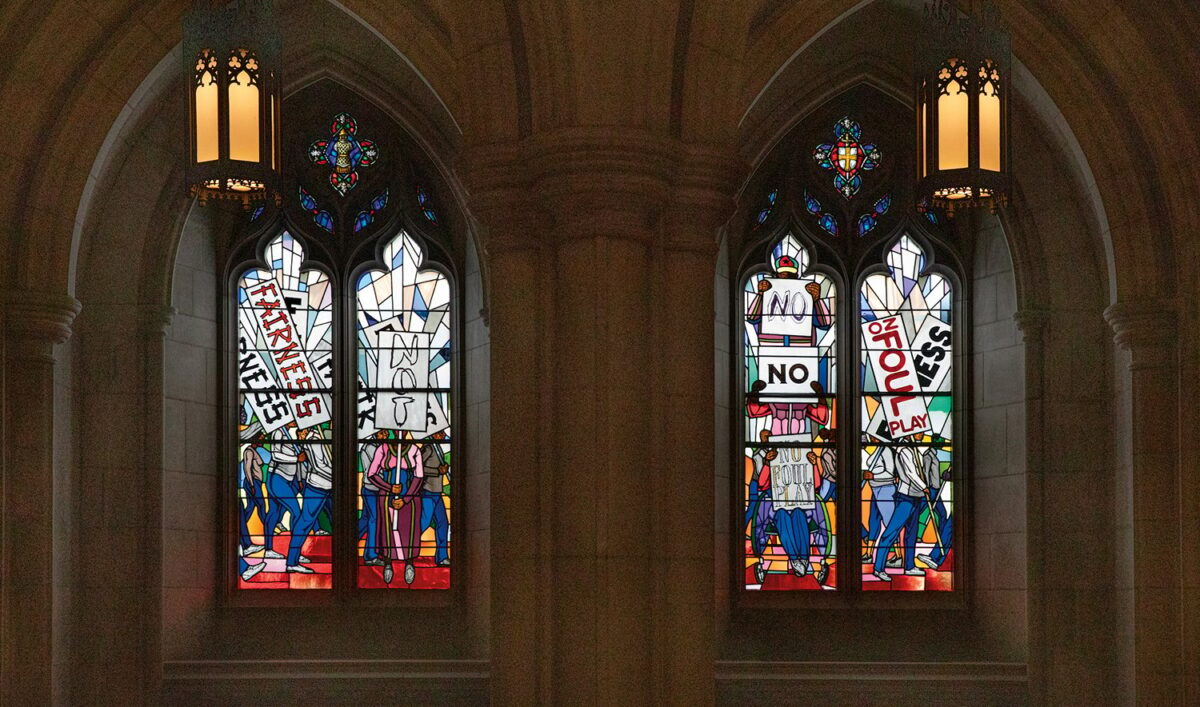
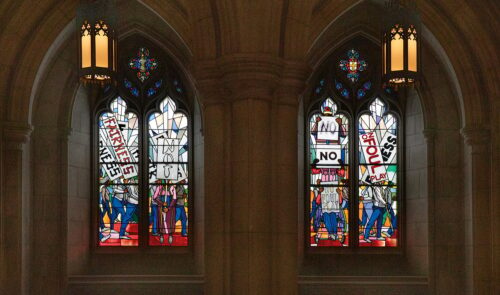
The Washington National Cathedral unveiled four newly created and installed stained glass windows on Saturday, Sept. 23, 2023. The previous windows were removed in part due to controversy over the Confederate figures that were featured in the images. Photo courtesy of Washington National Cathedral
WASHINGTON (RNS) — New stained-glass windows depicting racial justice protests by African Americans have replaced the panes honoring Confederate generals Robert E. Lee and Stonewall Jackson at the Washington National Cathedral.
The new additions, titled “Now and Forever” and designed by artist Kerry James Marshall, were officially revealed in a ceremony on Saturday (Sept. 23), two years to the day after cathedral officials announced Marshall would design them.
The colorful panes feature signs that say “Fairness” and “No Foul Play,” held by Black figures wearing white shoes. The stone below them will be inscribed with the words from the original poem “American Song,” penned by Elizabeth Alexander, the president of the Andrew W. Mellon Foundation.
The service began with a soloist’s rendition of “Balm in Gilead” and a procession that included Marshall and Alexander along with robed clergy. The dean of the cathedral, Randy Hollerith, then described the new windows — and the process of replacing the old ones.
“These windows were offensive and they were a barrier to the ministry of this cathedral and they were antithetical to our call to be a house of prayer for all people,” he said, describing the panes as elevating the Confederacy and ignoring Black Americans.
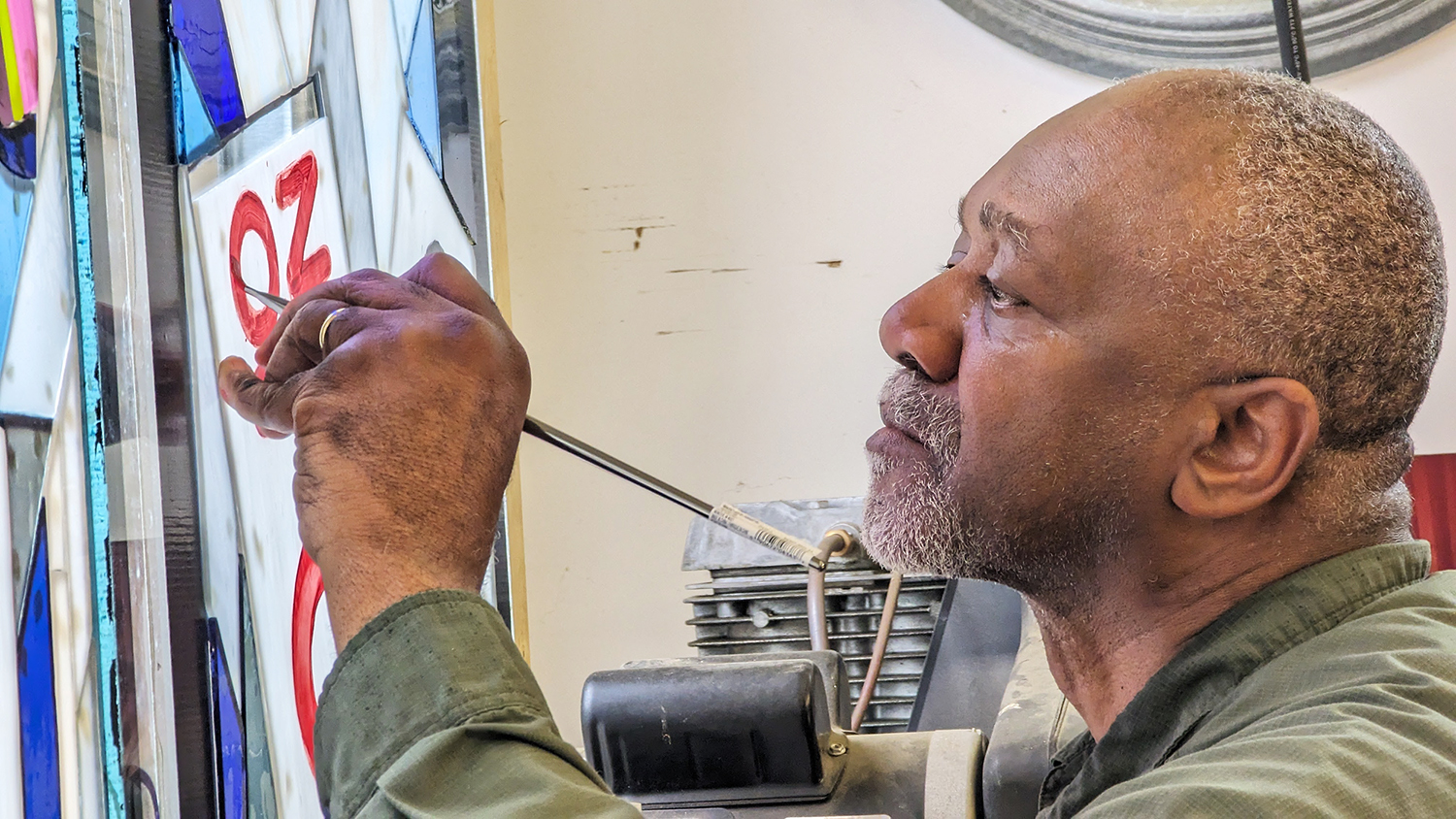
Artist Kerry James Marshall paints the letters of one of the signs included in the new stained-glass windows at the Washington National Cathedral. Photo courtesy of Washington National Cathedral
In contrast, the new additions, Hollerith said, are “windows and poetry that tell a different story, that lift up the values of justice and fairness and the ongoing struggle for equality among all God’s children. I’m so grateful to Kerry and Elizabeth for their willingness to share their art with us here at the cathedral, art that we hope and pray will live on here for centuries.”
The hour-and-a-half ceremony drew a crowd of more than 850 people on a particularly rainy day. Attendees included representatives of the Union of Black Episcopalians and leaders of several historic Black denominations. Harvard historian Henry Louis “Skip” Gates Jr. read from the New Testament book of Romans about hating evil and California Rep. Sydney Kamlager-Dove, Marshall’s stepdaughter, read a passage from Ecclesiastes that began, “For everything there is a season.”
A surprise reader was Supreme Court Justice Ketanji Brown Jackson, who intoned some of the words from the Rev. Martin Luther King Jr.’s “Letter from Birmingham Jail.”
“We will reach the goal of freedom in Birmingham and all over the nation, because the goal of America is freedom,” she read. “We will win our freedom because the sacred heritage of our nation and the eternal will of God are embodied in our echoing demands.”
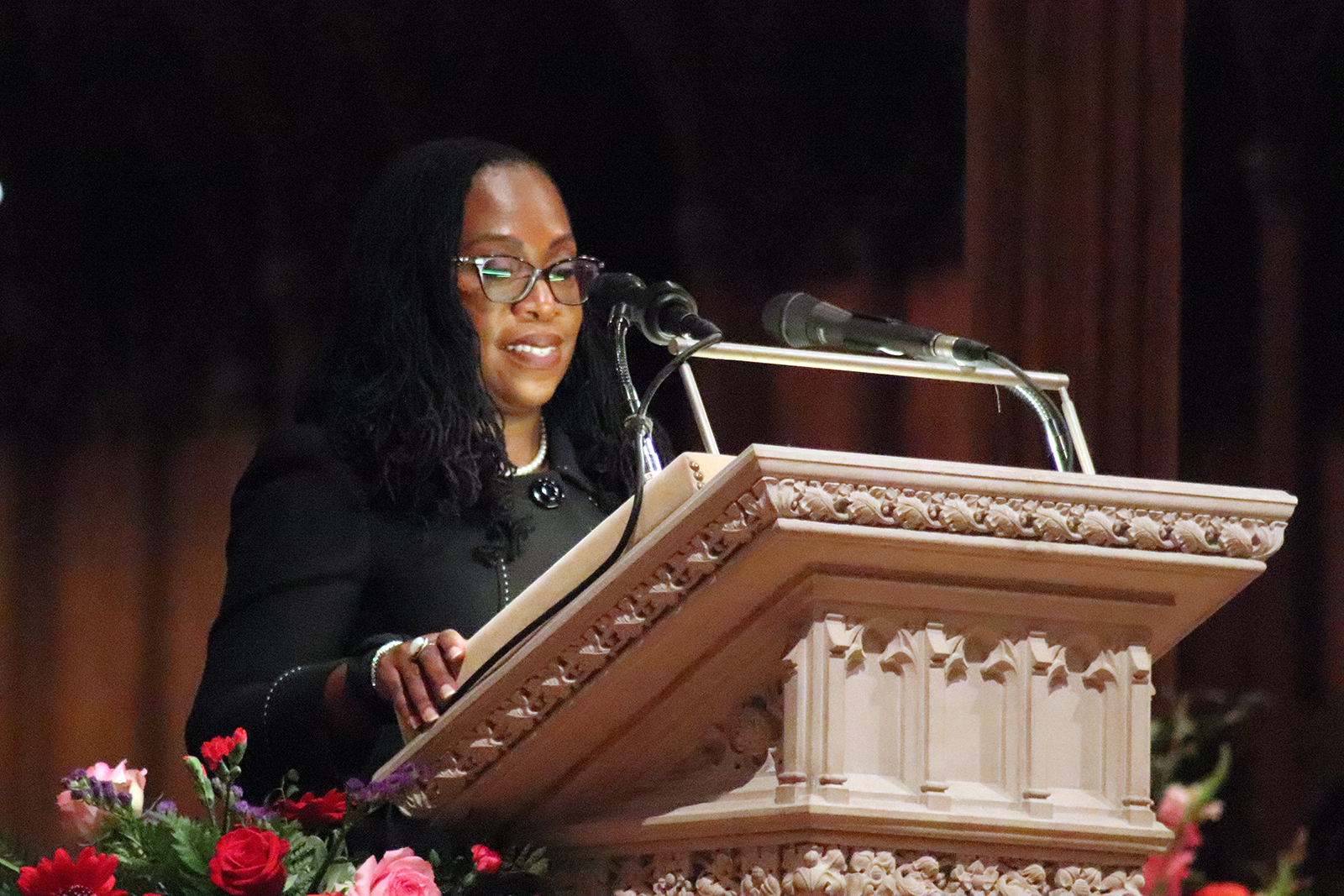
Supreme Court Associate Justice Ketanji Brown Jackson addresses an unveiling and dedication ceremony at the Washington National Cathedral for new stained-glass windows, Saturday, Sept. 23, 2023. RNS photo by Adelle M. Banks
Though Marshall, who was born in Birmingham in 1955, made remarks just before the dedication and blessing of the windows, he said he preferred his artwork to speak for itself.
“I am deeply humbled, incredibly grateful for the opportunity,” he said, “and hope that the themes that the windows propose continue to be a catalyst for the kind of transformation the cathedral stands for, that the nation stands for, for what I hope we all as members of this culture and society will embody and stand for and bring forward ourselves.”
He also thanked his collaborators, including Alexander — with whom he walked hand in hand when they joined the retiring procession at the service’s conclusion — and Andrew Goldkuhle, the stained-glass artist who cut and placed the more than 800 hundred pieces of colored glass to fit the design Marshall had created.

Kerry James Marshall signed and dated the new windows which can be spotted below the shoes in one of the four complete panels he designed. Photo courtesy of Washington National Cathedral
After he concluded, Marshall and Alexander joined clergy at the site of the windows for their dedication.
“Be with us now and bless us as these windows are set apart to your praise and glory,” prayed Episcopal Bishop of Washington Mariann Edgar Budde. “Grant that as the light shines through them in many colors, so our lives may show forth the beauty of your manifold gifts of grace.”
A companion volume released Saturday tells the story of the windows’ development and notes that Marshall, an artist who has been honored with a MacArthur “genius grant” and been named to Time 100 for his influence, did not expect a fee from the cathedral comparable to the millions paid for some of his other artwork.
He told Eric L. Motley, deputy director of the National Gallery of Art, and co-chair of the cathedral’s Windows Replacement Committee, that his fee would be $18.65, a marker of the conclusion of the Civil War, when slavery officially ended.
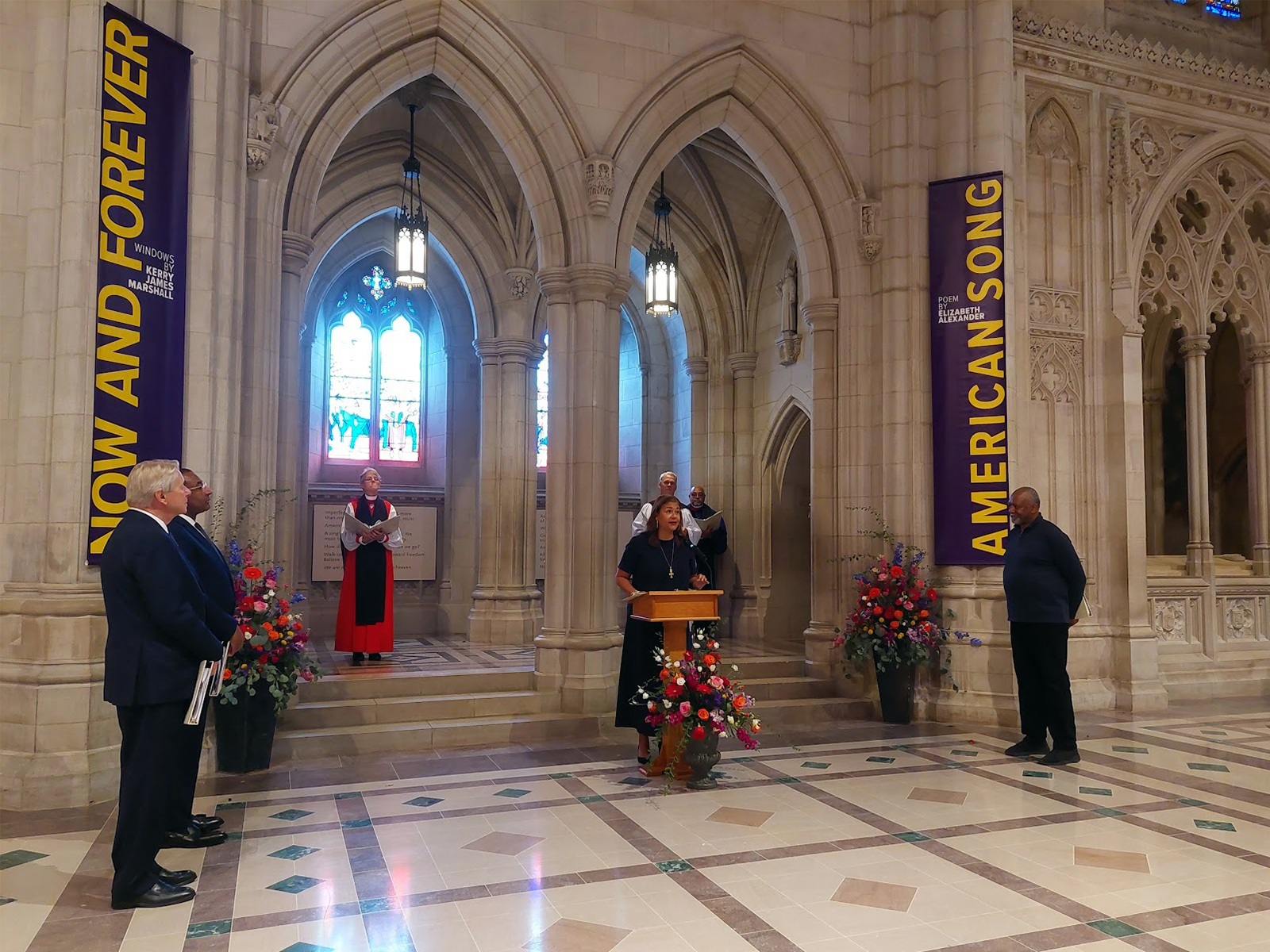
Elizabeth Alexander, center, recites her poem “American Song” during an unveiling and dedication ceremony at the Washington National Cathedral for the new stained-glass windows with a theme of racial justice, Saturday, Sept. 23, 2023, in Washington. Artist Kerry James Marshall is at right. RNS photo by Adelle M. Banks
The project, funded by $1 million from the Mellon Foundation, merged the art of Marshall with the words of Alexander, whose poem, “American Song,” includes a section that reads “ A single voice raised, then another. We must tell the truth about our history.”
Actress Kate Capshaw and her husband, film director Steven Spielberg, are providing additional funds for the planned hand-sculpting of the poem into the limestone tablets below the windows, through their Heartland Foundation.
The original Confederate-themed windows were installed in 1953 with the support of the United Daughters of the Confederacy, a group that wanted to memorialize veterans who had fought for the South.
Cathedral officials began considering replacing the windows after the 2015 slaying of nine people at Mother Emanuel African Methodist Episcopal Church in Charleston, S.C., by a white supremacist who was seen in photos brandishing the Confederate flag. The old windows were ultimately removed in the wake of a white supremacist rally in Charlottesville, Virginia, in 2017.
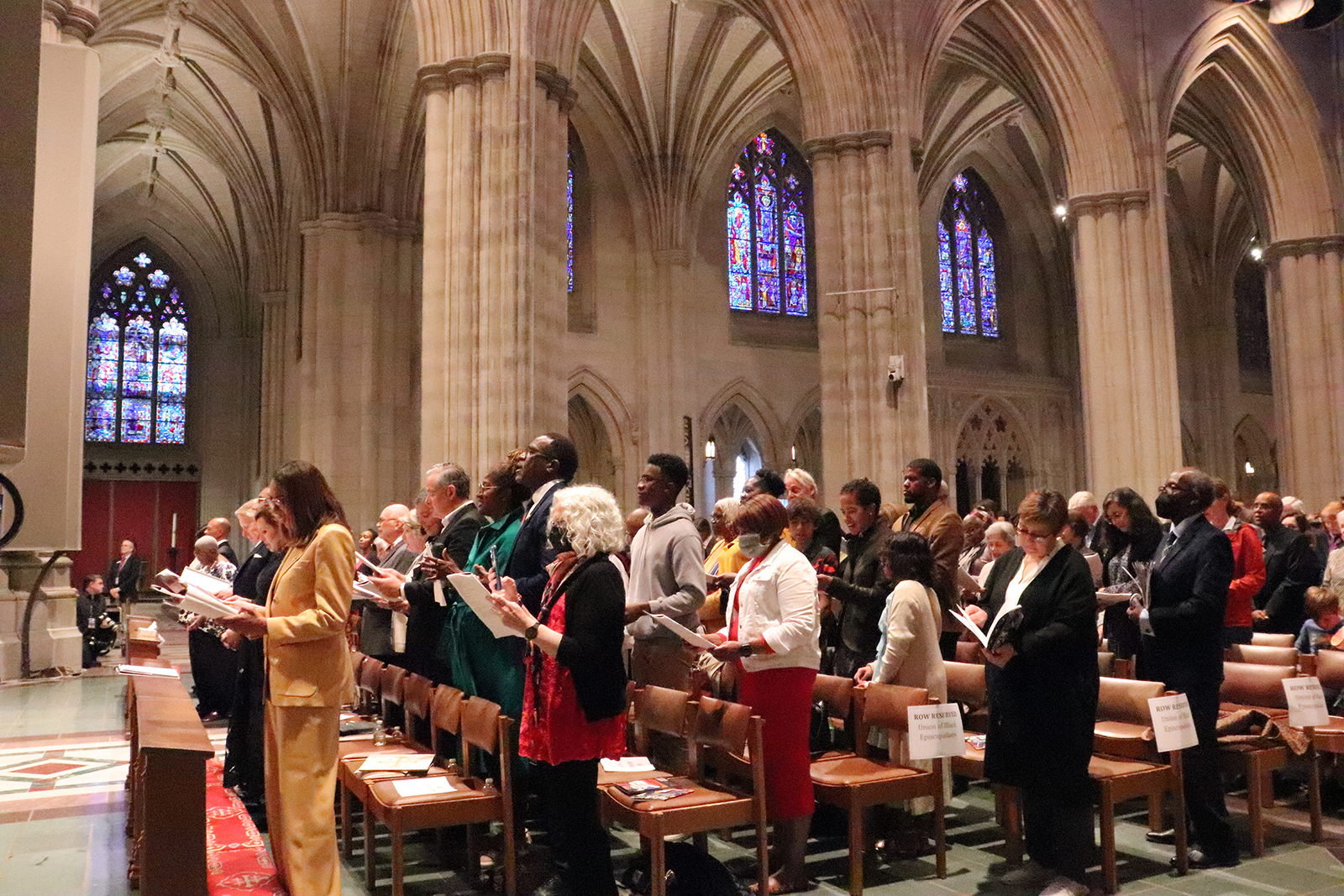
Hundreds of people attend an unveiling and dedication ceremony at the Washington National Cathedral for new stained-glass windows, Saturday, Sept. 23, 2023, in Washington. RNS photo by Adelle M. Banks
The Confederate windows, which were put on display in 2021 at the National Museum of African American History and Culture in a one-year exhibit, are now stored in the cathedral’s attic, said Kevin Eckstrom, chief communications officer for the cathedral.
During the service, Hollerith reminded the hundreds in attendance that the placement of the new windows are part of a continuum and not an end point.
“Today is an opportunity for us to recommit ourselves and to recommit this cathedral to joining that march towards fairness for all Americans, especially African Americans,” he said. “There is a lot of work yet to be done to confront systemic racism, to foster racial reconciliation, and to be repairers of the breach, both in our past and in our present and in the future.”
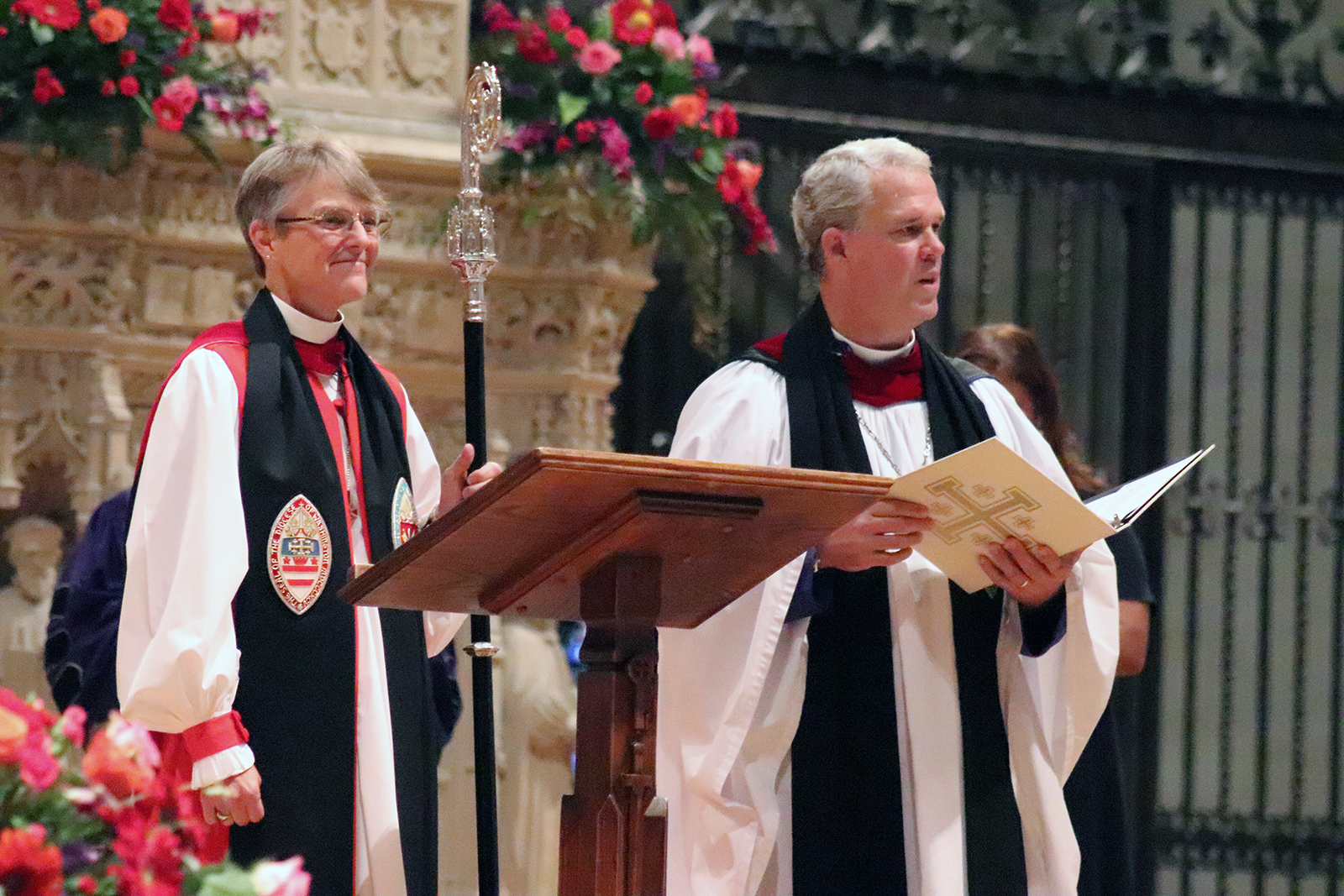
The Rt. Rev. Mariann Edgar Budde, left, and the Very Rev. Randy Hollerith officiate an unveiling and dedication ceremony at the Washington National Cathedral for new stained-glass windows, Saturday, Sept. 23, 2023. RNS photo by Adelle M. Banks

